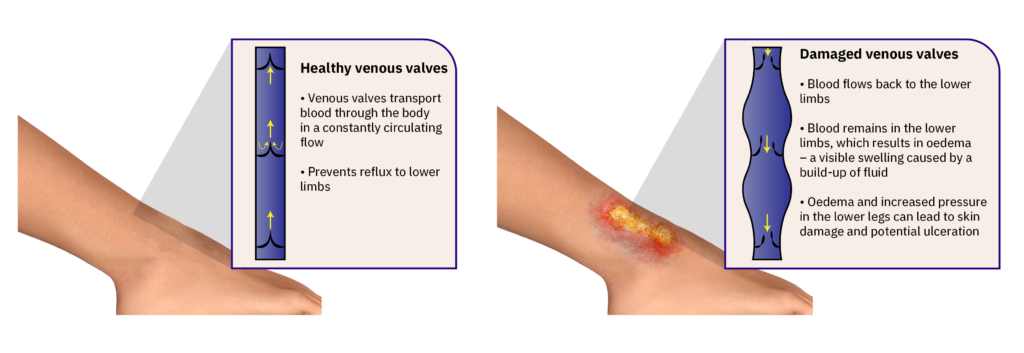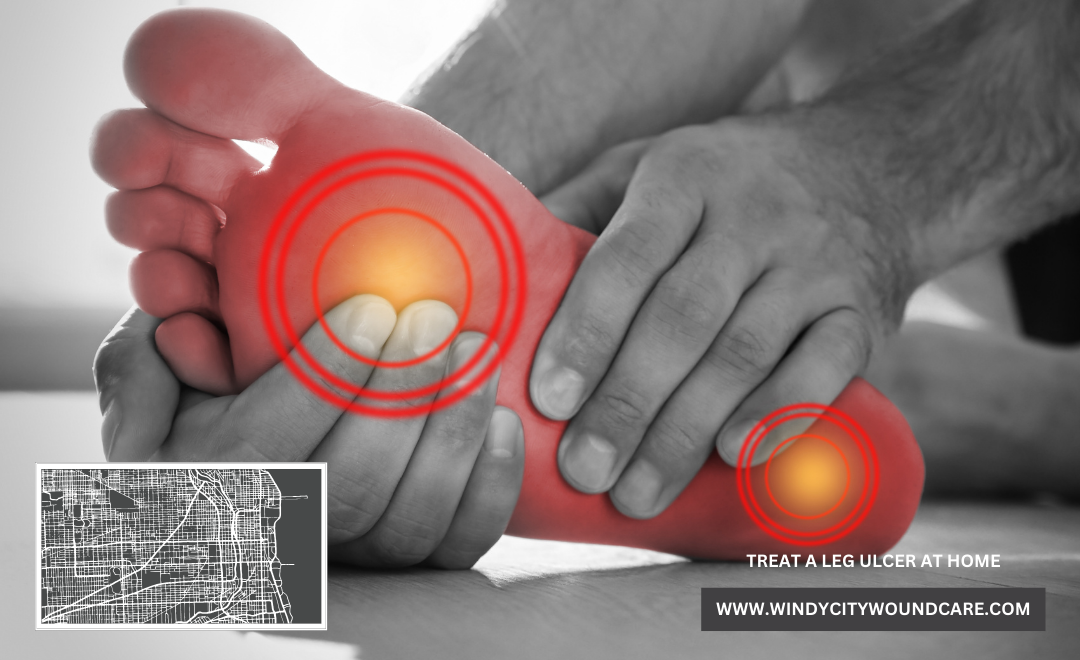A leg ulcer can be very painful, and it can also lower your self-confidence levels. It’s a good idea to learn how to treat a leg ulcer at home, but before we do that, we need to know how to identify it. Normally, a leg ulcer has symptoms like swelling in your ankles, leg discoloration, flaky and itchy skin, etc. If you have these symptoms, it’s a good idea to talk with a medical expert. However, there are various methods you can use to treat a leg ulcer at home as well.
Understanding how to treat a leg ulcer at home can help speed up the healing process and prevent complications. By using natural remedies, proper wound care, and lifestyle changes, you can improve circulation and promote recovery. Incorporating treatments like aloe vera, compression socks, and apple cider vinegar into your daily routine can make a significant difference in managing and healing leg ulcers effectively.
What Causes Venous Leg Ulcers?
The most common cause is that blood is pooling in your legs. Normally, that will happen because the veins are blocked, scarred or they become weak. If you have that kind of venous insufficiency, that will increase pressure levels in the lower leg veins. What that means is oxygen and nutrients will end up not reaching the tissue, so you will form wounds, not to mention the tissues get damaged, and cells will start dying due to no access to nutrients and oxygen.
In this informative video, Professor Mark Whiteley discusses effective methods for curing venous leg ulcers, referencing national guidelines from the UK.
How to Treat a Leg Ulcer at Home: Effective Remedies
Aloe vera
Aloe vera is used for healing various diseases, and it can be great if you want to learn how to treat a leg ulcer at home. The reason why it’s effective for leg ulcers is because it helps suppress the development of bacteria while also preventing any infection. Another thing to note about aloe vera is that it has hormones and anthraquinones that provide wound-healing properties.
How can you use aloe vera to treat your leg ulcer at home? You make a small incision in the aloe vera leaf and then use a scraper to remove the jelly-like material from the leaves. You can then apply gel to the leg ulcer.
Wear compression socks
Compression socks can be great because they help boost your circulation in the lower extremities. A lot of the time, the healing process is prolonged because nutrients and blood can’t properly reach your wound. The role of compression socks is to help improve your blood circulation while also reducing any swelling and pain. If you’re looking for effective methods on how to treat a leg ulcer at home, compression socks are a great option to consider. Make sure that you test different types of compression socks until you find the right ones that deliver the utmost comfort.
Use tea tree oil
Tea tree oil is a great antiseptic solution for your leg ulcer. It’s suitable for treating a multitude of skin diseases, and it’s known for being very effective when it comes to tackling leg ulcers. Additionally, it has very good anti-inflammatory and antibacterial properties.
Clean and moisturize the wounded area
One of the best ways to encourage leg ulcer healing is to moisturize and clean the area as much as you can. It will help protect the skin while eliminating any complications. If any bacteria reaches the wounded area, that could be very problematic, so cleaning and moisturizing it often (preferably on a daily basis), that will help quite a bit!
Make sure that your wound’s dressing and the skin are dry
The important thing to keep in mind here is that you don’t want to have the healthy tissue wet because it will become softer, and the wound will get bigger and bigger. Obviously, that becomes an issue, and you must address it the best way that you can.

Apple cider vinegar
Apple cider vinegar is an excellent at-home treatment for your leg ulcer. One of the advantages you get from apple cider vinegar is that it has a lot of acetic acid, along with various minerals and vitamins. It can be very good against microbial diseases, including leg ulcers. If you’re looking for natural remedies, how to treat a leg ulcer at home, apple cider vinegar is a great option to consider.
Combine the ACV with some warm water in a bowl. You soak a piece of cloth in that solution, and then you place it on the wound. Leave it there for up to 15 minutes and repeat the process twice a day. You will see results rather quickly.
Turmeric
It’s also possible to use turmeric for treating your leg ulcer at home. Since turmeric is known for its anti-inflammatory and antioxidant components, it can help promote wound healing. It also has curcumin, which has exceptional anti-inflammatory properties.
But how can you treat your leg ulcer with turmeric? You combine turmeric powder with water and then apply the paste to the affected area. You let it dry out and then use warm water to wash it off. It’s ok to do this 2-3 times a day if you want to have the best results.
Coconut oil
Just like turmeric, coconut oil can help battle any bacteria while protecting your skin and encouraging the healing process. It’s a good idea to take 1-2 tbsp of coconut oil and apply it on the leg sores. Do this 2 times a day, and it won’t take more than a couple of weeks to see improvements!
Honey
If you’re wondering how to treat a leg ulcer at home, maybe you may want to try healing it with honey. Yes, honey is actually great for your leg ulcer because it has antibacterial and anti-inflammatory properties. It can help alleviate pain, not to mention it reduces discomfort and swelling. Another benefit of honey is that it’s antimicrobial, which prevents re-infection.
You need to take some organic honey and add it to your fingertips. Then, you apply it to the leg ulcer and leave it there for up to 15 minutes. Wash it off, and then repeat this 2-3 times on a daily basis. It can have a very positive impact on your leg ulcer’s healing process.
Put up your feet so they are over your heart’s level
It’s a very good way to promote circulation, and doing this is quite easy, too. The idea is to put the feet on 1-2 pillows. You want the feet to be over your heart’s level since it’s very helpful and will allow you to encourage leg ulcer healing. Combine it with the other ideas and tips above, and you can get some very good results.
Exercise or take a walk every day
Another way to encourage your leg ulcer to heal is to exercise and take a walk every day. Why is this important? If you’re active, that helps improve the blood flow, which in turn will boost your leg ulcer’s healing process.
Other things to consider:
- If you’re overweight, that extra weight will have a negative impact on your blood flow and leg ulcer healing speed. Reduce your weight and try to improve your diet. Plus, regular exercise will help quite a bit.
- You need to protect the affected leg as much as possible. Wearing well-fitting footwear that’s also very comfortable will help immensely.
- Stop smoking and reduce your alcohol consumption. That also helps improve your blood flow, and it can indeed help your leg ulcer heal a lot faster.
- Taking certain supplements might also help if you suffer from certain deficiencies.
- Clean the leg ulcer with sterile salt water, if possible. It allows you to eliminate any bacteria while preventing any further infections.
If you’ve been following various home treatments but aren’t seeing improvement, you may be wondering, why is my leg ulcer not healing? Factors like poor circulation, infection, or underlying health conditions can slow down the healing process. Understanding these obstacles and addressing them properly can make a significant difference in your recovery. Learn more about the possible reasons for delayed healing and expert-recommended solutions in the linked article.
Conclusion
How to treat a leg ulcer at home requires the right approach, and there are various options to consider. In general, you can use honey, turmeric, aloe vera, or a saline solution to clean, protect, and heal your leg ulcer wounds. Additionally, keeping your legs elevated while resting can aid in the healing process. Wearing compression socks can also help improve blood flow while reducing swelling. For expert wound care and professional guidance, visit Windy City Wound Care. Use these tips along with professional care to effectively manage and heal your leg ulcer.
Windy City Wound Care is dedicated to providing expert treatment and compassionate care for individuals suffering from chronic wounds, including leg ulcers. With a team of highly skilled medical professionals, we specialize in advanced wound care solutions designed to accelerate healing, reduce discomfort, and prevent complications. Our patient-centered approach ensures that each treatment plan is tailored to meet individual needs, whether through cutting-edge medical therapies or at-home care guidance. If you’re struggling with a non-healing wound, trust Windy City Wound Care to deliver the expertise and support needed for a smooth recovery. Visit our website to learn more about our services and schedule an appointment today.


